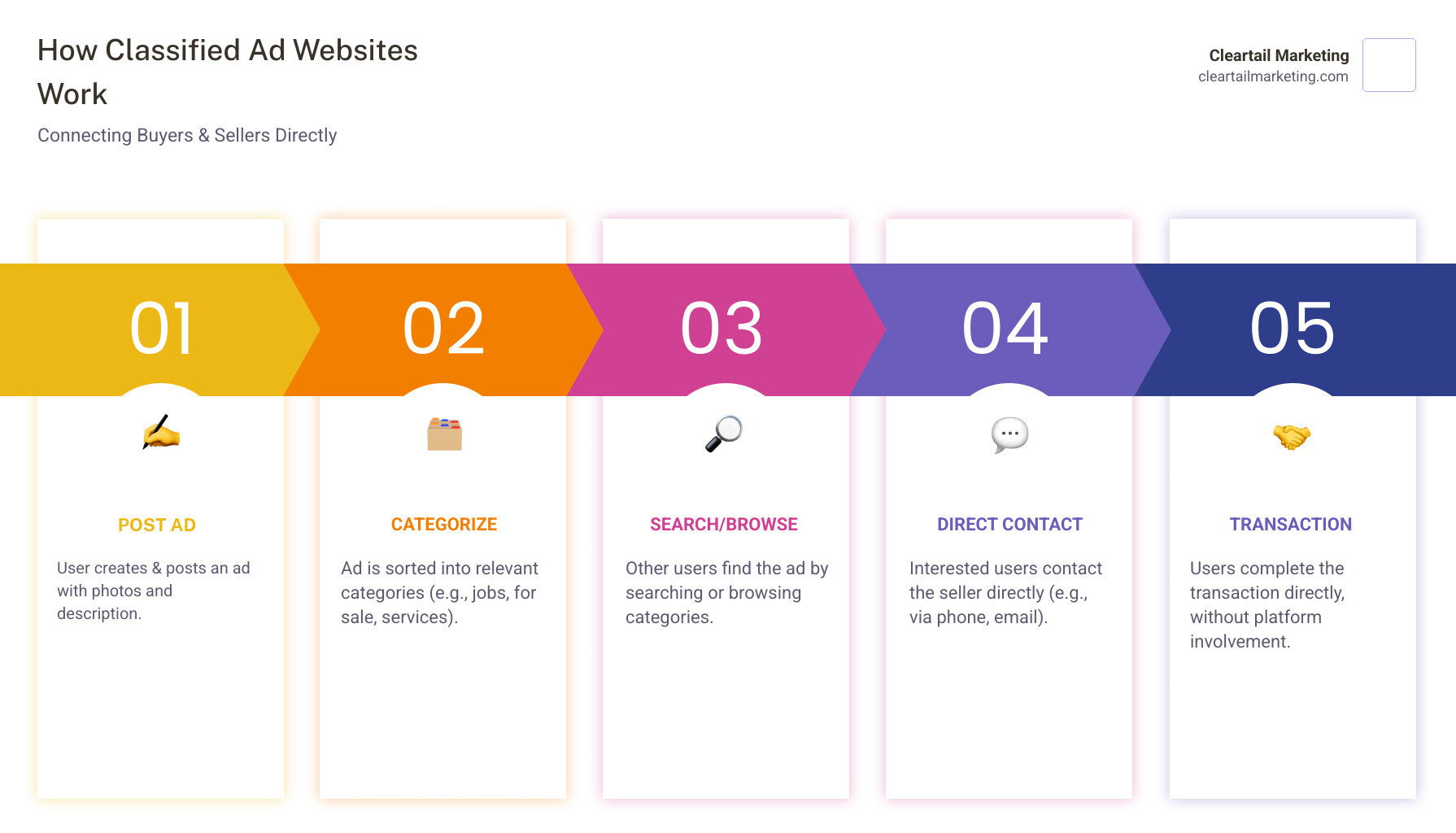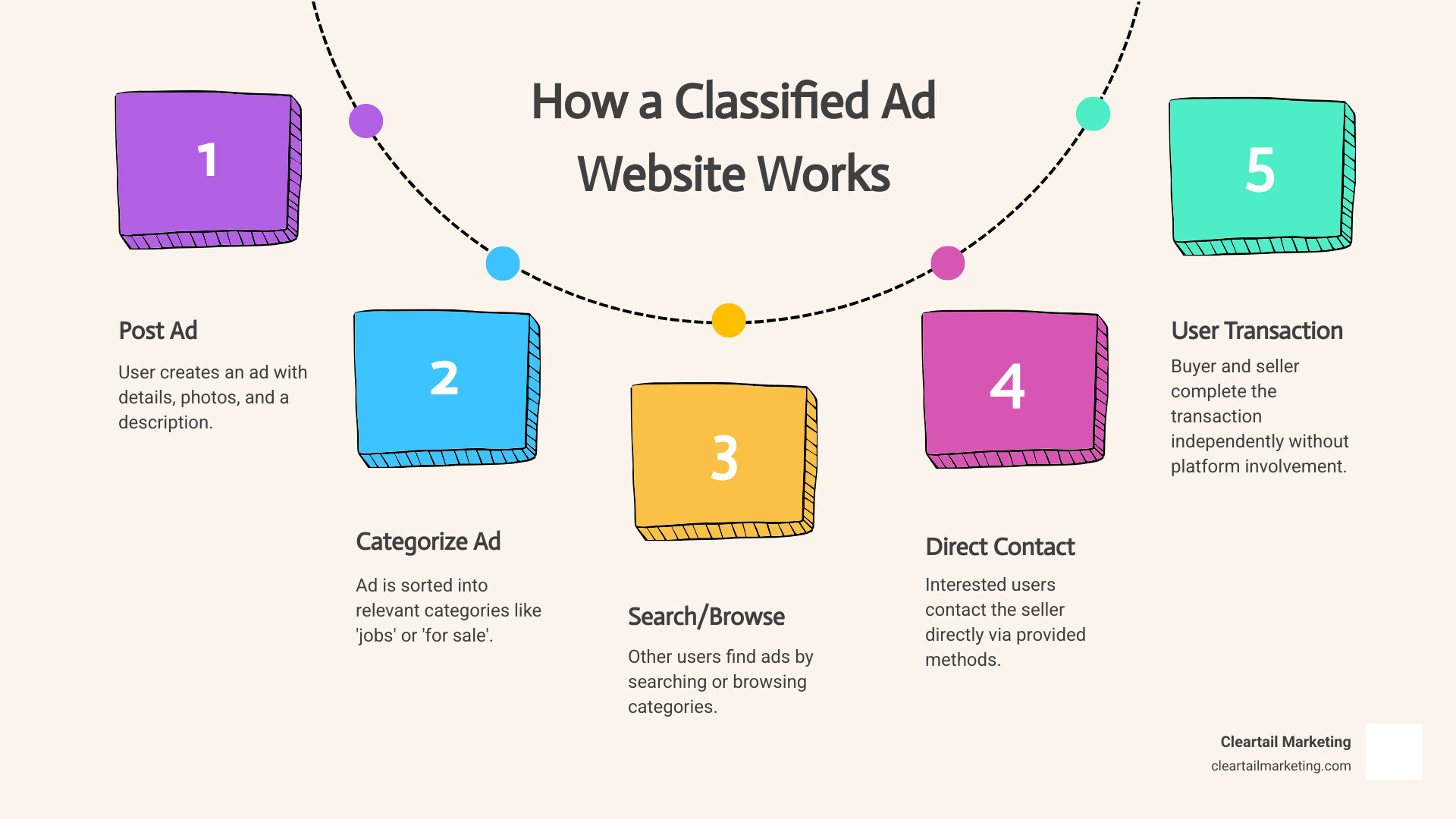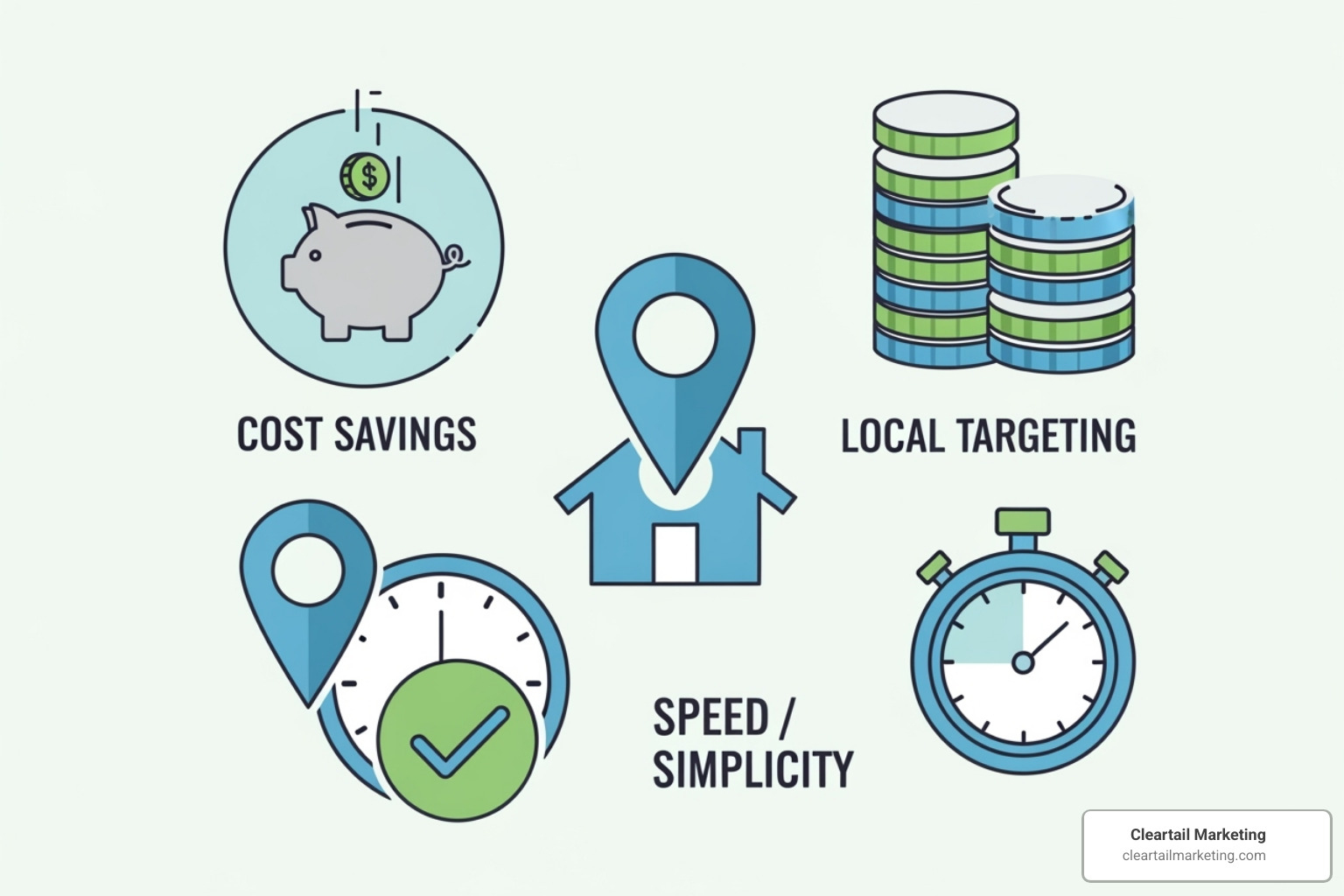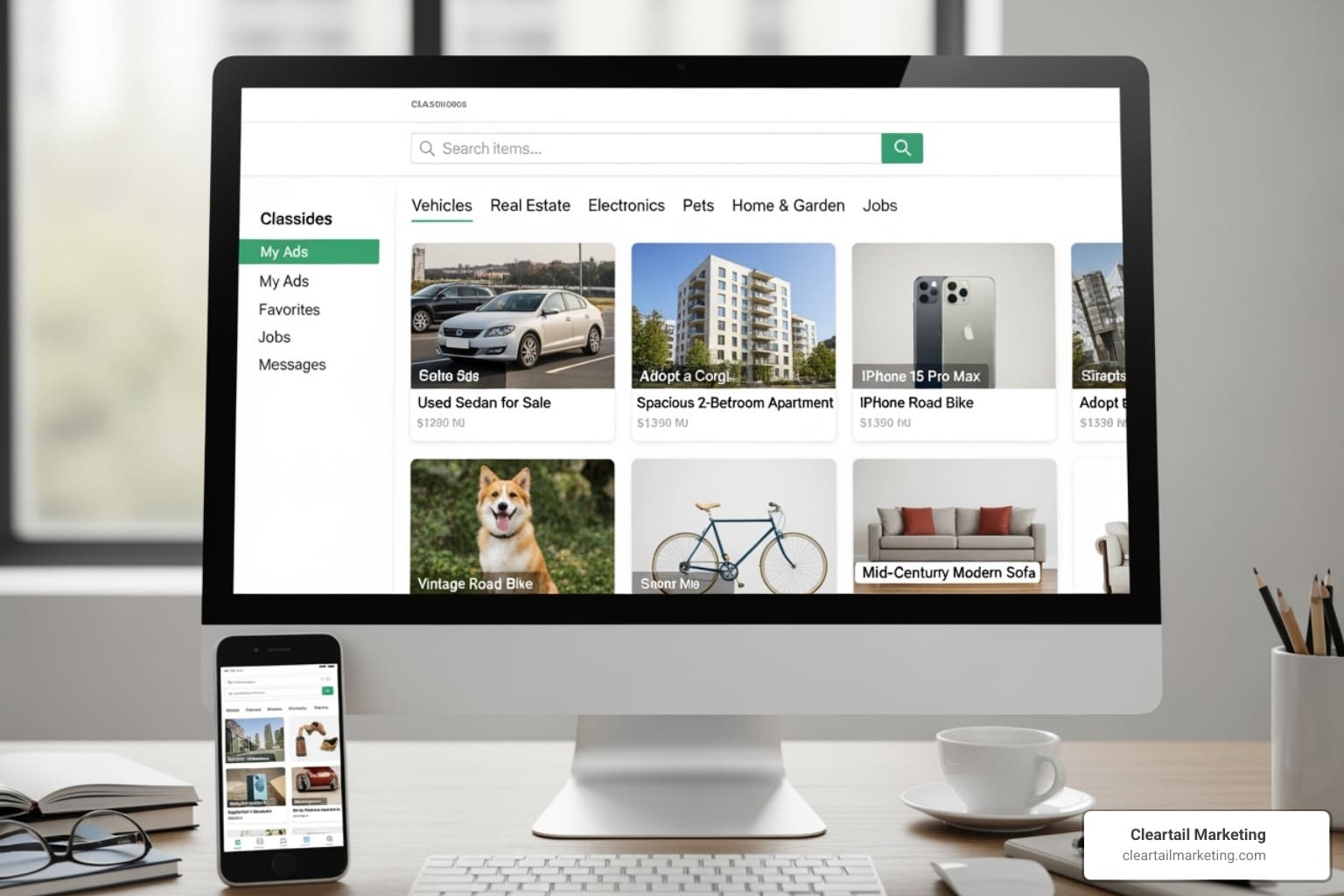The Digital Evolution of the Classified Ad
A classified advertisement website is an online platform where users post ads to buy, sell, rent, or trade goods and services, connecting directly with each other. These sites range from general marketplaces like Craigslist to specialty platforms for real estate, cars, or jobs.
Key Things to Know About Classified Ad Websites:
- They’re free or low-cost – Most allow free posting, making them ideal for small businesses and individuals.
- They’re local-first – Many focus on connecting buyers and sellers in specific geographic areas.
- Users connect directly – The platform facilitates contact but doesn’t handle transactions.
- They cover everything – Categories span from furniture and electronics to jobs, housing, and services.
- They’re still growing – The global online classifieds market is expected to grow from $10.5 billion in 2022 to $17.9 billion by 2027.
The classified ad has evolved from paid-per-word newspaper listings to instant, often free online posts with photos and direct messaging. Sites like Craigslist still attract over 60 million monthly users in the US, proving the model’s relevance.
For small business owners, these platforms are a cost-effective way to reach customers who are actively searching for a specific product or service. Unlike disruptive ads, classifieds connect you with people who have already expressed interest.
I’m Magee Clegg, founder of Cleartail Marketing. We’ve helped numerous companies grow using cost-effective digital strategies, including optimizing their presence on classified advertisement websites for local visibility. In this guide, I’ll show you how to leverage these platforms effectively.

Understanding the Classified Advertisement Website Ecosystem
To leverage these platforms, you need to understand how they work, what sets them apart, and the different types available.
How Classified Ad Websites Function
A classified advertisement website is a digital bulletin board where users post what they’re selling, needing, or offering. The core function is to facilitate direct connections. Unlike e-commerce sites that manage the entire transaction, classifieds introduce the two parties and then step aside.

The process is straightforward: a seller posts an ad with photos, a description, price, and location. A buyer searches the classified advertisement website using keywords or categories. When they find a match, they contact the seller directly through the platform’s messaging or listed contact info to negotiate and arrange the transaction.
This direct, personal interaction and local focus make these platforms powerful for bulky items, local services, or anything where a face-to-face meeting is beneficial.
Classifieds vs. E-commerce: What’s the Difference?
People often confuse classified advertisement websites with e-commerce marketplaces like Amazon, but they serve different purposes.

| Feature | Classified Ad Sites (e.g., Craigslist, Hoobly) | E-commerce Marketplaces (e.g., Amazon, Etsy) |
|---|---|---|
| Transaction Model | Direct buyer-seller negotiation; platform is a facilitator. | Platform often mediates payment, shipping, and returns. |
| Primary Focus | Local, niche, second-hand goods, services, jobs. | Global, new products, branded goods, larger businesses. |
| Fees | Typically free to post, sometimes small fees for premium features. | Commission-based fees, listing fees, advertising costs. |
| User Role | Platform connects users; users handle transaction logistics. | Platform acts as an intermediary; provides infrastructure for full transaction. |
| Product Type | Wide variety, often unique, used, or locally sourced items/services. | Standardized, mass-produced goods, digital products. |
| Customer Service | Handled directly by buyer/seller. | Often provided or managed by the platform. |
| Trust Mechanism | User reviews, direct communication, personal judgment. | Platform guarantees, buyer/seller protection policies, detailed ratings. |
The key difference is the transaction model. Classifieds facilitate direct negotiation, while e-commerce platforms mediate the entire transaction. This also affects the primary focus—local and niche for classifieds versus global for e-commerce—and cost, with classifieds being mostly free while e-commerce sites charge commissions. Think of classifieds as a digital community yard sale and e-commerce as a store in a global mall.
Types of Classified Platforms: From General to Niche
Not all classified advertisement websites are the same. Knowing the different types helps you find the right audience.
- General Sites: These are the Swiss Army knives of classifieds, with categories for everything. Examples include Craigslist, which remains a dominant force, along with Oodle and Hoobly.
- Local Platforms: These sites, like NextDoor and local Facebook groups, focus on connecting neighbors within a specific community.
- Specialty Sites: These platforms go deep on a single category, attracting serious buyers. Think Zillow for real estate, Autotrader for cars, or Indeed for jobs. Hoobly also has strong niche categories like pets.
- Social Media Marketplaces: Platforms like Facebook Marketplace have become popular by integrating buying and selling into existing social networks.
At Cleartail Marketing, we help clients choose the right platforms to match their offerings with where their ideal buyers are already looking. The key is to align your product or service with the platform that best serves that niche.
A User’s Guide: Strategies for Success and Safety
Let’s explore how to use classified advertisement websites effectively while staying safe.
The Benefits of Using a classified advertisement website
These platforms offer unique advantages that are often underestimated.

- Cost-Effectiveness: Most platforms allow free posting, offering direct customer exposure without the high cost of traditional ads.
- Local Targeting: These sites naturally connect you with people in your geographic area who are looking for local goods and services.
- Speed and Simplicity: You can create and publish an ad in minutes without complex approval processes.
- High-Quality Leads: Users on these sites have high purchase intent; they are actively searching for what you offer, leading to better conversion rates.
- Diverse Categories: There’s a place for almost anything, from job postings and services to used goods and community events.
Best Practices for Posting and Searching
A strategic approach can make the difference between a listing that gets ignored and one that sells quickly.

For Sellers:
- Create a Descriptive Headline: Instead of “Couch for sale,” use “Comfortable Gray Sectional Sofa – Like New, Pet-Free Home.”
- Use High-Quality Photos: Take clear, well-lit photos from multiple angles. Be honest about any flaws to build trust.
- Write a Detailed Description: Explain the benefits, not just features. Include dimensions, condition, and other relevant details.
- Set a Fair Price: Research similar items on the platform to price competitively.
- Include a Call-to-Action (CTA): Tell people exactly how to contact you.
- Optimize for Mobile: Ensure your ad is easy to read on a phone, where most users browse.
For more guidance, check out these tips for effective ad submission.
For Buyers:
- Use Specific Keywords: Search for “women’s road bike 54cm” instead of just “bike” to narrow your results.
- Use Filters: Use tools for price range, location, and condition to save time.
- Read Carefully and Ask Questions: A good seller will provide more details if needed.
- Compare Listings: Check multiple ads to understand fair pricing and expected condition.
Staying Safe: How to Avoid Scams and Mitigate Risks
The open nature of classified advertisement websites requires caution. Knowing the red flags can help you avoid common scams.
- Recognize Red Flags: Be wary of deals that seem too good to be true. A brand-new iPhone for $200 is likely a scam.
- Protect Personal Information: Never share your social security number, bank details, or passwords. Avoid phishing links in messages asking you to “verify” your account.
- Avoid Common Scams: Watch out for overpayment scams, where a “buyer” sends a fake check for too much and asks you to wire back the difference.
- Meet Safely: Always meet in a public, well-lit location, like a coffee shop or a police station’s designated exchange zone. Tell someone your plans.
- Use Secure Payment: For small transactions, cash is best. For large ones, consider meeting at a bank. Avoid wire transfers or gift cards with strangers.
- Check User Profiles: Use platform features like reviews and ratings to gauge trustworthiness.
- Trust Your Gut: If a conversation or situation feels off, walk away. Your safety is more important than any transaction.
Many sites provide their own safety guidelines; it’s worth reviewing these safety tips for online classifieds before you start.
The Future of Classifieds: Trends and Innovations
The world of classified advertisement websites is constantly adapting to meet the demands of a sophisticated digital audience.
From Static Listings to Dynamic Experiences
Today’s users expect a richer experience than the text-only ads of the past. The best platforms are delivering with several key innovations:
- Mobile-First Design: Flawless performance on smartphones is now essential, as most users browse on the go.
- Video Listings: Walkthroughs of apartments or demonstrations of equipment build trust and provide more detail than static photos.
- Integrated Messaging: In-app communication systems streamline conversations and keep them organized within the platform.
- Sophisticated User Profiles: Verification badges, transaction histories, and public reviews help establish trust between users.
- Community Features: Discussion forums and interest groups create a more engaging platform that goes beyond simple transactions.
These features are changing the classified ad from a simple notice into a rich, interactive experience.
The Role of AI and Personalization in the future of the classified advertisement website
Artificial intelligence is revolutionizing how classified advertisement websites operate behind the scenes, making them smarter and safer.
- AI-Powered Search: Instead of just matching keywords, modern search engines understand user intent and context to provide more relevant results.
- Automated Fraud Detection: AI algorithms can proactively identify suspicious listings, flag stolen photos, and catch scam attempts before they affect users.
- Personalized Recommendations: By learning from your browsing history and location, platforms can suggest relevant items you might be interested in.
- Augmented Reality (AR) Previews: Emerging technology like AR will soon let you virtually place an item like a couch in your living room to see how it fits before you buy.
- Hyper-Local Targeting: Advanced geolocation combined with AI will enable even more precise local notifications and connections, such as alerts for a garage sale happening a few blocks away.
The future of the classified advertisement website is bright. At Cleartail Marketing, we’re excited to help businesses leverage these evolving tools as part of a comprehensive digital strategy.
Frequently Asked Questions about Classified Ad Websites
At Cleartail Marketing, we often get questions about whether classified advertisement websites still have a place in a modern marketing toolkit. Let’s address the most common ones.
Do classified ad sites help with SEO?
Yes. Posting on a reputable classified advertisement website can create valuable backlinks to your business site, drive referral traffic from interested users, and increase your local visibility. These are all positive signals for search engines like Google. While not a magic bullet, it’s a solid component of a comprehensive local SEO strategy, complementing efforts like Google Business Profile optimization.
Are classified submission sites still relevant?
Absolutely. The global online classifieds market is projected to grow to $17.9 billion by 2027. Their relevance endures due to focused user intent—users are actively looking to buy, not just browse. They also offer a vast range of categories and excel at local and niche reach, connecting communities in a way large e-commerce platforms can’t. Their cost-effectiveness makes them an essential tool for individuals and small businesses.
Can I promote my business through classified ads?
Yes, they are an excellent, cost-effective channel for business promotion. Classifieds connect you with customers who have high purchase intent and are actively searching for your products or services. This is especially valuable for local service providers (e.g., plumbers, tutors) due to the inherent local targeting. You can advertise services, sell products, post job openings, and more. To be successful, create compelling ads, provide value, and always follow the platform’s guidelines to avoid being marked as spam. At Cleartail Marketing, we can help integrate this tactic into a broader digital strategy.
Conclusion: Using the Power of Online Classifieds
The classified ad has successfully evolved from print to become a powerful digital tool. Classified advertisement websites offer a simple, direct, and cost-effective way for individuals and businesses to connect for commerce, especially at a local level.
Throughout this guide, we’ve covered how to craft effective ads, stay safe, and understand the ecosystem. By following best practices, users can open up immense value. As technology like AI continues to improve these platforms, their role in marketing will only grow.
For businesses, classifieds are an efficient way to reach customers with high purchase intent. It’s targeted marketing at its best—connecting with people who are actively looking for what you offer. At Cleartail Marketing, we integrate classified ad strategies into comprehensive digital marketing plans to drive real growth.
If you’re ready to harness the full potential of online classifieds as part of a comprehensive marketing strategy, we’re here to help. Our team knows how to optimize your presence across digital channels to drive real growth for your business.



